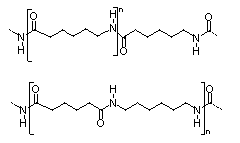Nylon 6
 | |
| Names | |
|---|---|
| IUPAC name
poly(hexano-6-lactam) | |
| Other names
polycaprolactam, polyamide 6, PA6, poly-ε-caproamide, Perlon, Capron, Ultramid, Akulon, Nylatron, Kapron, Alphalon, Tarnamid, Akromid, Frianyl, Schulamid, Durethan | |
| Identifiers | |
| 25038-54-4 | |
| ChemSpider | |
| PubChem | 24850915 |
| Properties | |
| (C6H11NO)n | |
| Density | 1.084 g/mL |
| Melting point | 493 K |
| Hazards | |
| 434 °C; 813 °F; 707 K | |
| Except where noted otherwise, data is given for materials in their standard state (at 25 °C (77 °F), 100 kPa) | |
| Infobox references | |

Nylon 6 or polycaprolactam is a polymer developed by Paul Schlack at IG Farben to reproduce the properties of nylon 6,6 without violating the patent on its production. It is a semicrystalline polyamide. Unlike most other nylons, nylon 6 is not a condensation polymer, but instead is formed by ring-opening polymerization; this makes it a special case in the comparison between condensation and addition polymers. Its competition with nylon 6,6 and the example it set have also shaped the economics of the synthetic fiber industry. It is sold under numerous trade names including Perlon (Germany), Nylatron, Capron, Ultramid, Akulon, Kapron (former Soviet Union and satellite states), and Durethan.
Synthesis
Nylon 6 is synthesized by ring opening polymerization of caprolactam. Caprolactam has 6 carbons, hence 'Nylon 6'. When caprolactam is heated at about 533 K in an inert atmosphere of nitrogen for about 4-5 hours, the ring breaks and undergoes polymerization. Then the molten mass is passed through spinnerets to form fibres of Nylon 6.

During polymerization, the amide bond within each caprolactam molecule is broken, with the active groups on each side re-forming two new bonds as the monomer becomes part of the polymer backbone. Unlike nylon 6,6, in which the direction of the amide bond reverses at each bond, all nylon 6 amide bonds lie in the same direction (see figure: note the N to C orientation of each amide bond).

Properties
Nylon 6 fibres are tough, possessing high tensile strength, as well as elasticity and lustre. They are wrinkle-proof and highly resistant to abrasion and chemicals such as acids and alkalis. The fibres can absorb up to 2.4% of water, although this lowers tensile strength. The glass transition temperature of Nylon 6 is 47 °C.
Applications
Nylon 6 finds application in a broad range of products requiring materials of high strength. It is widely used for gears, fittings, and bearings, in automotive industry for under-the-hood parts, and as a material for power tools housings.[1] Nylon 6 is used as thread in bristles for toothbrushes, surgical sutures, and strings for acoustic and classical musical instruments, including guitars, sitars, violins, violas, and cellos. It is also used in the manufacture of a large variety of threads, ropes, filaments, nets, and tire cords, as well as hosiery and knitted garments. It can also be used in gun frames, such as those used by Glock, which are made with a composite of Nylon 6 and other polymers. It has the potential to be reused as a technical raw material for the production of new Nylon 6, by depolymerization to caprolactam.[2]
Biodegradation
Flavobacterium sp. [85] and Pseudomonas sp. (NK87) degrade oligomers of Nylon 6, but not polymers. Certain white rot fungal strains can also degrade Nylon 6 through oxidation.[3]
References
- ↑ Galanty, P. G. (1999). Polymer Data Handbook. Oxford University Press. p. 180. ISBN 978-0195107890.
- ↑ Tyler, C. "Cows in the Loop – Cradle to Cradle concepts supported by Materials Innovation". Matter (materialconnexion.com) 4.4.
- ↑ Tokiwa, Y.; Calabia, B. P.; Ugwu, C. U.; Aiba, S. (2009). "Biodegradability of Plastics". International Journal of Molecular Science 10 (9): 3722–42. doi:10.3390/ijms10093722. PMC 2769161. PMID 19865515.